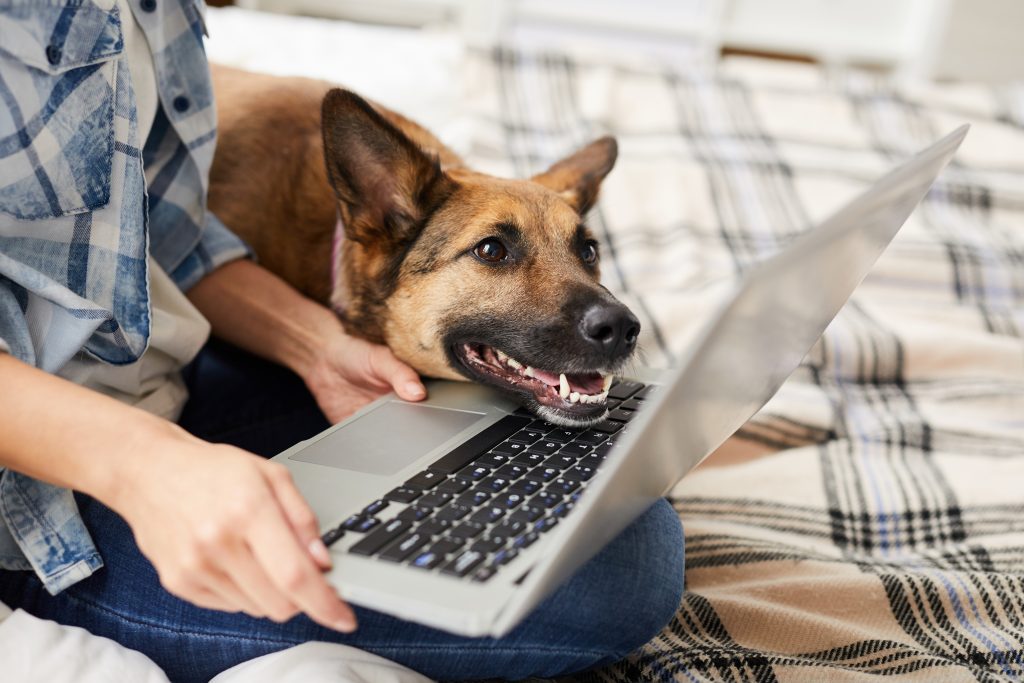If you are a dog lover, the news that you will be Working From Home (WFH) must have delighted you. This means that you don’t need to entrust your beloved pooch to a dog sitter because you’ll be in the office the whole day. Now that you are homebound, you can devote more time to your dog’s care.
But this joy is only in the beginning.
A couple of weeks later, you come to realize that WFH with a dog can be quite challenging. Let’s face it. How can you spend long hours typing away at your computer and teleconferencing with bosses and co-workers when your dog is giving you cute puppy eyes, whining or, worse, barking for your attention?
If your beloved canine is making WFH difficult for you, we are here to give you some tips on how you can work from home with dogs.
Understanding Your Dog’s Reaction to Your WFH
Dogs thrive well in a structured and routine environment. So, suffice to say, your working from home will be a major change in their daily routine. Whereas before they will expect you to give them a pat on the head or a hug before you march out the door, this time, your dog will definitely notice that you are staying home day after day after day.
Once your dog “understands” that you are stuck at home, in their minds, they think that you will be spending more time with them, although the reverse is true because you will be working the same number of hours as you did in the office.
Because of this, your dog becomes desperate to get your attention through whining, tugging at your clothes, or barking. Pretty soon they get so bored and frustrated at the sight of you working that they end up doing more and more destructive behaviors. Conversely, you also start to notice behavioral problems in your dog which you have noticed before because you were always in the office.
It is best to deal with these behavioral problems early on before it gets worse.
Tips On Working From Home With Your Dog
1) Always be patient and realistic
It’s best to start our tips off with this bit of advice. You must always remember that your dog is a living, breathing being. No matter what rules or plans you set, there will be occasions when things will not work as they should. When this happens, you should always be patient with your dog. Be realistic enough to accept that what may work one day may not work the next. Instead, adapt yourself to every situation that arises.
2) Always start and end your day by walking your dog
There is truth to that wise adage: “A tired dog is a happy dog.” Bringing your dog out for 20- to 30-minute walks is good for its physical, emotional, and mental well-being. A walk around the neighborhood or a run at the park are not only great exercises for your dog, but also enable it to release pent-up energies. Allowing them to sniff and explore their surroundings helps to mentally stimulate them. By making morning and evening walks a part of your dog’s routine, you not only deepen your bond with it, but you also tire it out so that it rests, sleeps, or remains calm throughout the hours that you will be working. Therefore, it is advisable to time concentrated work after these walks.
3) Add playtimes with your dog into your daily schedule
Adding designated playtimes to your daily schedule will help in giving the dog the structure and routine it needs in its day. These playtimes should be around 20 minutes long instead of very short play periods. You can schedule these playtimes after working for two to three hours straight or as part of your coffee and lunch breaks. What is important is that you structure your day so that your dog can know when to expect that you will give it your attention and play with it.
4) Allot an independent space for your dog
Crate training is particularly critical if you will be working from home. A crate or a gated space in your home will serve as your dog’s personal safe haven. This allows you to set boundaries between your work space and that of your dog’s. Never use the crate or its designated space as a punishment or “time out zone.” It is important that your dog feels comfortable in this space so that it can sleep or play in it while you work. Make sure that place your dog’s favorite toys inside. A great distraction for your dog is puzzle toys that contain treats.
5) Ignore your dog’s demands for attention
This is probably the most difficult but the most important tip of all. As we have said earlier, your dog will do anything and everything to get your attention. They may whine, paw or nudge your leg with their head, bark, or start bumping or knocking things to the floor. One irresistible plea for attention are those notoriously cute puppy eyes.
Whatever your dog does, ignore it. PERIOD. You should not scold your dog or push it away. Any type of reaction to it means that you’re giving it the attention it wants, even if it’s a scolding. Even looking at your dog in the eyes is also a sign of your attention. Just continue working and wait. Once your dog starts playing with its toys or lies down, make sure that you impress upon it that this is desirable behavior by giving it a treat as a reward AFTER you have finished the work that you are doing; never before you are done.
6) Distract your dog during teleconferences and important calls
It can be embarrassing to say the least when you are in the middle of an important phone call, chat, or Zoom meeting and your dog starts barking in the background. In some cases, your little mischief maker may even come over and pop its head up so that everyone can see its grinning face on their screens. While nothing can be cuter than having a dog gatecrash your Zoom, it can derail your meeting.
If you have a scheduled meeting, distract your dog with its favorite toy. Kong puzzle toys filled with treats can keep your dog occupied. Especially during hot summer days, you can also give your dog a frozen treat for it to lick until your meeting is over.
Let your dog be a delight instead of a distraction for you. Just follow our tips so that you can have a harmonious time working from home with your dog.


